- Home
- Collections
- AXFORD J
- Joy Story - A Memoir
Joy Story – A Memoir
CONTENTS
The Early Years 5
England 1957-1960 9
Ottawa 1960-1963 11
Napier 1963 13
Ithaca, New York 1963-1967 15
La Jolla, California 1967-1974 19
Germany 1974-1982 23
Back to New Zealand 1982- 29
Joy’s Poem 33
Afterwords 34
Reader: There are available blank pages on which you can add a photo or information that I have missed.
22 July 2022
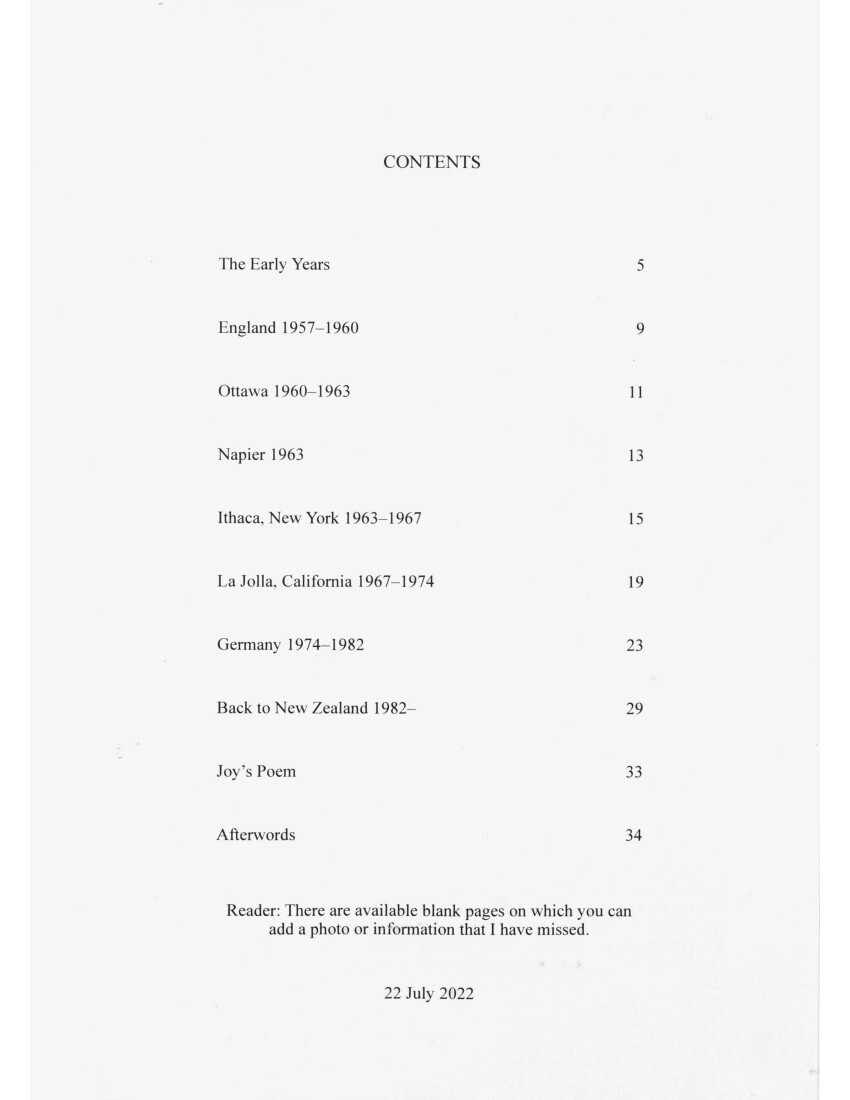
Page 5
THE EARLY YEARS
I came into the world on 21 March 1932 in Napier, born in the nursing home of Nurse Wright, 49 Nelson Crescent. My parents were Jim and Kate Lowry who lived at 154 Nelson Crescent and I was their third daughter. I have fond memories of the house, built by my father, who lived there until 1983. It was a spacious and comfortable bungalow. The background of our family can be found in The Lowry Family in New Zealand, which I published in 2015.
I attended Te Awa Primary School, Napier Intermediate School and spent five years at Napier Girls’ High School, which had also been attended by my older sisters, Jean and Melva. The school was (and still is) situated on Bluff Hill, overlooking the expanding city. The daily trip to school meant a bicycle ride to the foot of Shakespeare Road, where there was a shed for our bikes, and a walk with school bags up Brewster Steps, or, alternatively, up Shakespeare Road to Corry Avenue, to enter the school yard.
I was a slightly above average student during my school days and especially enjoyed physical education, sport and singing. I and my twin sisters, who were born three and a half years after me, spent our leisure time (when we were not reading) pursuing outdoor activities: playing in the camp, swimming, battling the waves at the Napier boundary, or lying on the shingle getting sunburnt. Our father built ‘Joyland’, our own play area, in the backyard. This was a real small house in which the children could play with their dolls and toys and read books. We spent many happy hours there, and much later, ‘Joyland’ was used for storing cases of apples in the winter.
I played tennis at the Nelson Park courts or at the Hawke’s Bay Lawn Tennis Club, enjoyed skating, playing badminton at the Drill Hall, once winning the Hawke’s Bay doubles title, partnered by Jim Thompson, and representing Napier Girl’s High School on the basketball courts on Marine Parade. Everywhere I went was reached by way of my bicycle, kept in good condition by my father.
I need to mention that our older sisters, Jean and Melva, often returned to the family home. Jean and son Ian stayed until they were fortunate to rent a state house in Nuffield Avenue in Marewa. When Melva and Ralph returned from England with sons David and Michael, they lived in the house next door to us, built and owned by our father. Our mother did not possess a washing machine, but she was grateful when an electric wringer was installed in the 1940s.
The Lowry girls: Joy and twin sisters Josephine and Elizabeth, dutifully attended Sunday School in Wesley Hall on McGrath Street, an offshoot of Methodist Trinity Church in Napier, which was situated opposite Clive Square. Our beautiful Sunday dresses were made by a dressmaker.
I moved on to bible class at Trinity and enjoyed the Easter camps. This was a chance to have a trip away, even if it was only to the Greenmeadows Racecourse. Learning later that I was christened a Presbyterian, I joined the bible class of St Paul in town, was confirmed by Reverend McKenzie and made many friends, some of whom I still see (at the time of writing). Having achieved a reasonable standard playing the piano, my interest in music was noted by Stan Pearce, the organist, and he taught me the workings of the instrument I still love. I relieved for him for many years and, later, on return trips home.

Page 7
In 1950 and 1951 I attended Ardmore Training College with other teacher trainees drawn mainly from country areas. We were accommodated in buildings recently used by participants in the 1950 Empire Games. Friends were made for life there. It was a unique establishment, which lasted until 1975, I believe. Some university subjects were available form Auckland University, so this was where I began a Bachelor of Arts with Education 1. I furthered an interest in singing and was in Ramsey Howie’s choir, which produced Purcell’s Dido and Aeneas, and also The Christ by Eric Mareo, who wrote the oratorio whilst in prison for murdering his wife.
As students, we were paid the sum of five pounds monthly after our board had been deducted. This was usually spent immediately on an evening out in the big city. We would travel by train from Papakura Station to Auckland, have a meal at a café, then shop or attend a Gilbert and Sullivan opera or whatever else was currently touring New Zealand. The last train back left at 11.30 pm and an Ardmore transit bus would be at the station to return us to the college campus.
I enjoyed the experience of living on-site in term time and appreciated family life in the holidays. I was one of a group of seven friends, of which at the time of writing, I am one of the remaining four. Training completed, my probationary year was spent teaching the new entrants at Marewa School under the watchful eye of Miss McPherson. This was followed by two years as music specialist at Napier Intermediate School – a fun time working with friendly accomplished teachers, some of whom had taught me. My outside interests were still tennis and badminton and attending occasional concerts at the beautiful Napier Municipal Theatre. I continued to play the organ for church, weddings and funerals, reliving [relieving] for Mr Pearce on various occasions.
In 1951, I met a handsome local boy named Ian Axford, who was also interested in music – but definitely not religion. We married at my parents’ house on 12 January 1955 and honeymooned in Hamilton, staying with an aunt of Ian’s, as he was participating in a cricket match. We moved to Christchurch, where Ian was studying mathematics and engineering at Canterbury College, and I was appointed music specialist at Shirley Intermediate School. I attended Music 1 and Philosophy 1 classes at the university during my two years there. We always moved back to Napier for the long summer holidays – Ian was a keen and accomplished cricketer. Our son Paul Ian was born on 10 December 1955 and one year later, Catherine Suzanne was born on 29 December 1956, also in Napier. By this time Ian, who had an incredible intellect, had achieved master’s degrees in both Science and Engineering and I had three units for my BA. However, it was apparent that our lives were just beginning.
Ardmore Training College friends:
Betty, Ngaire, Joy, Shirley, Margaret, Jill, Dawn

Page 9
ENGLAND 1957-1960
On 31 July 1957, our family, now consisting of Ian and Joy with eighteen-month-old Paul and six-month-old Susie, said goodbye to family and friends at Napier Airport, waving to Ian’s father, Jack, who was in the hospital, recently admitted with a heart condition. We boarded the SS Rangitane in Auckland for London, England.
It was a six-week voyage via Pitcairn Island and the Panama Canal, which was an engineering and historical highlight. Ian had won a New Zealand Defence Research scholarship, enabling him to further his study at Manchester University, well known to New Zealanders by way of Rutherford and Marsden.
Arriving in London, we stayed briefly at the Regent Palace Hotel in Piccadilly and then took the train to Manchester, where we stayed at the grand Midland Hotel while searching for somewhere suitable to live. This was not an easy task with two small babies so Ian decided to buy a car. We bought a station wagon, found a house outside Manchester in the village of Gatley (Cheshire), and stayed in a B&B in Didsbury until the house became free. We often ate at one of the many new and popular Indian restaurants in the area and I caught the Asian ‘flu.
No. 9 Westend Avenue was a very nice detached house, situated in a cul de sac, with garden and amenities such as a washing machine and gas heating. Ian drove daily to the university, situated in the highly industrialised – and polluted – city centre. We exchanged babysitting with New Zealanders Don and Glenys Smith, who also lived in Gatley. Over the back fence lived a lovely Irish family by name of McCann, and a friend of our landlady would often call in on her way to the shops.
We drove to Glasgow to meet the sister and daughters of Ian’s grandmother one very snowy weekend. Needing to stop on return we stayed in Dumfries, which we discovered was the home of Robert Burns. On Sundays we would explore the beautiful landscape and villages of Knutsford and Wilmslow nearby. A visit to Blackpool, where Paul had a donkey ride on the extensive sandy beach, was an exciting experience.
Early in 1958 we received word that Ian’s father Jack, had sadly passed away. I have mentioned that he was diagnosed with a heart problem before we left and was in hospital.
Ian was fortunate to work under Dr Goldsworthy and Professor (later) Sir James Lighthill FRS in the Department of Mathematics at Manchester University. At that time a television series named The Sky at Night presented by Patrick Moore (later Sir Patrick) was Ian’s inspiration for a career in space. Patrick came to our house in Wellington in 1983 and we found he was also a talented musician. Years later I heard played at a local concert a work he had written for organ to commemorate the Galileo journey to Halley’s Comet.
Ian played as much cricket as possible, captaining the university team and playing for Werneth. I noticed that a local artist by the name of Lowry was having an exhibition of his paintings in Salford, so we attended the opening. L.S. Lowry’s works depicted life in industrial Manchester – history now, and can still be viewed in Salford Art Gallery.
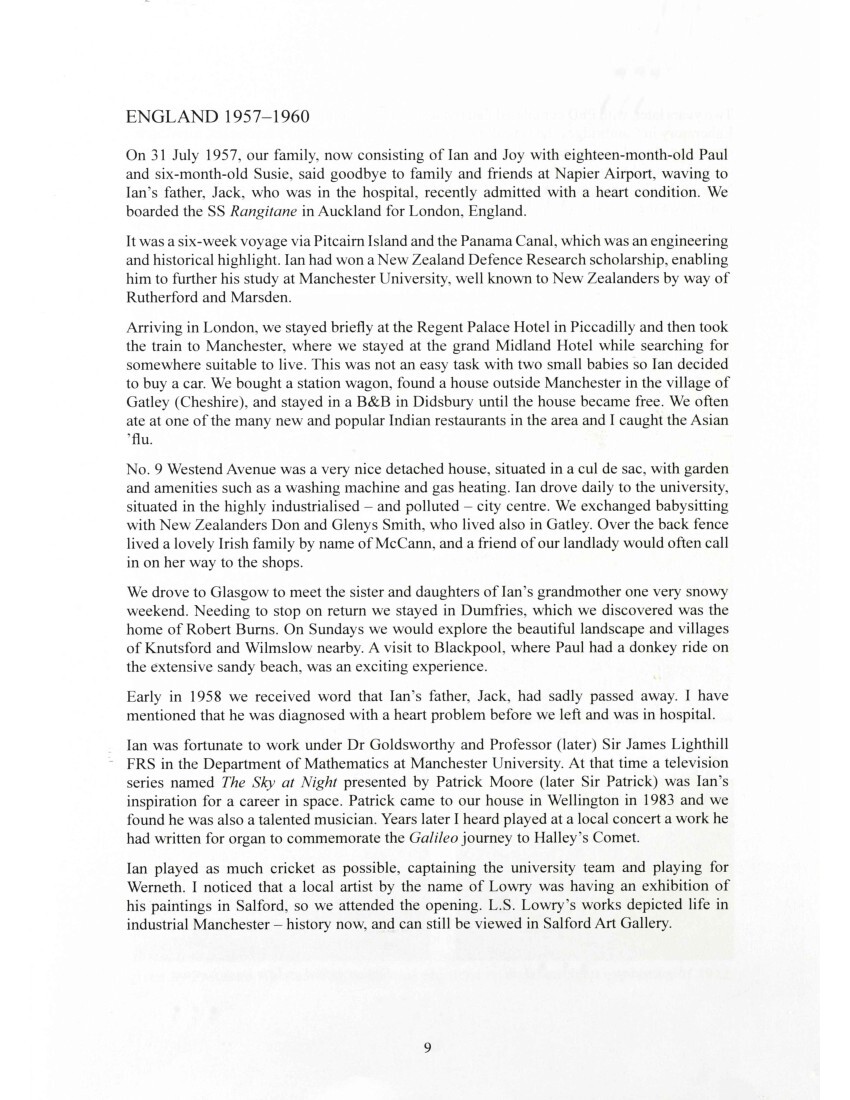
Page 10
Two years later, with PhD completed, Ian requested that he continue to study at the Cavendish Laboratory in Cambridge – he was allowed one year. We drove from Manchester, arriving in dense fog, found an apartment at 8A Metcalfe Road and for one year enjoyed the ambience of the beautiful town and the River Cam. During our time in England we entertained many New Zealanders enjoying an overseas trip, or their OE, as it was called. I was able to go to London on the occasion of the wedding of Princess Margaret to Lord Snowden [Snowdon] in 1960. Ian played major counties cricket on Fenners cricket field representing Cambridge, his great dream come true.
9 Westend Avenue, Gatley, Cheshire
Watching cricket at Fenners
At home, Cambridge
Sightseeing – ruins near Bath
Sir Ian Axford and Sir Isaac Newton

Page 11
OTTAWA 1960-1963
NZ Defence Science Fellowships of the time lasted six years. Three years having passed, towards the end of our stay in Cambridge, Ian was informed that he would now be employed at the DSIR, a government research establishment at Shirley Bay in Ottawa, Canada. He was to join a group of four scientists led by Colin Hines, with George Reid, and Jules Fejer.
There was not much time to pack for the impending journey across the Atlantic Ocean on the Empress of France. Ian hastily bought a new car, a black Triumph; we each packed a suitcase, and boarded the Canadian Pacific vessel on 7 October, 1960. After a seven-day journey, we cruised up the St Lawrence River and disembarked at Montreal. The time difference between continents was five hours, which was unsettling for Paul and Susie, who woke up an hour earlier every day.
A drive to Ottawa followed. Ian contacted Bill Rainbird, a former lecturer at Canterbury who was working at the university there. He kindly invited us to stay while we sorted out our future accommodation for the next three years. We decided on 2716 Violet Street, a new duplex in Britannia Bay, a suburb on the bus route to Shirley Bay and close to the Ottawa River. We lived on the top floor of the duplex. The tracks for the Canadian Pacific Railway were 100 yards away and when the warning bells rang at 11.30 every night, Paul would jump out of bed to watch the train pass. Google Earth tells us that the train no longer uses the route.
Although not really prepared for the bitter weather in Ottawa, we learned to sled and ice skate. Ian enjoyed playing cricket in the summer with other dislocated members of the empire in the beautiful grounds of the Governor General at Rockliffe Park. There we made good friends. Neighbours in Britannia Bay were friendly, in particular the Gow family and Ingrid Kaulbars, a German woman who later visited us in Germany. Money was not great; Paul and Susie slept on camp stretchers we had brought from NZ and we had no curtains until Mum sent us $40 one Christmas. During our stay Paul attended Grant School; Susie spent the morning with the Kaulbars family and went to kindergarten with Lulu and Kiki in the afternoon while I taught at a nursery school. When Susie went to Grant, I relieved in local schools. Occasionally on a snowy morning I would drive to school with full lights, forget to turn them off on arrival and at three o’clock find that my car would not start. There was no garage at the duplex but cars are plugged into an outlet on the house to keep the battery alive overnight. My memories were of a warm house in a cold winter.
Ontario is a place of many lakes set in the pine forests. The Hines family had a cottage on one and invited us there in the summer holidays. A lasting friendship was formed when we met Jules’ wife, Cisca, and their daughter, Stella, in Ottawa. We visited Upper Canada Village with a visiting Australian family, and gazed at a display of the mounted policed. Dorothy and Ray Meyer, Paula Scaife and family, all from NZ, lived in Ottawa at the time.
Ian was eventually ordered back to NZ to complete the contract with the Defence Science Board. On the basis of a research paper written in 1962 with Colin Hines, he was offered positions at various universities in the United States. We did a tiki-tour to Dallas, Chicago and Vancouver Island were Paul attended a school called St Paul’s School. We were invited to a slide lecture on the emperor penguin at the University of British Columbia in Vancouver given by Professor Charles Wright. He was physicist on the fatal Scott expedition of 1912
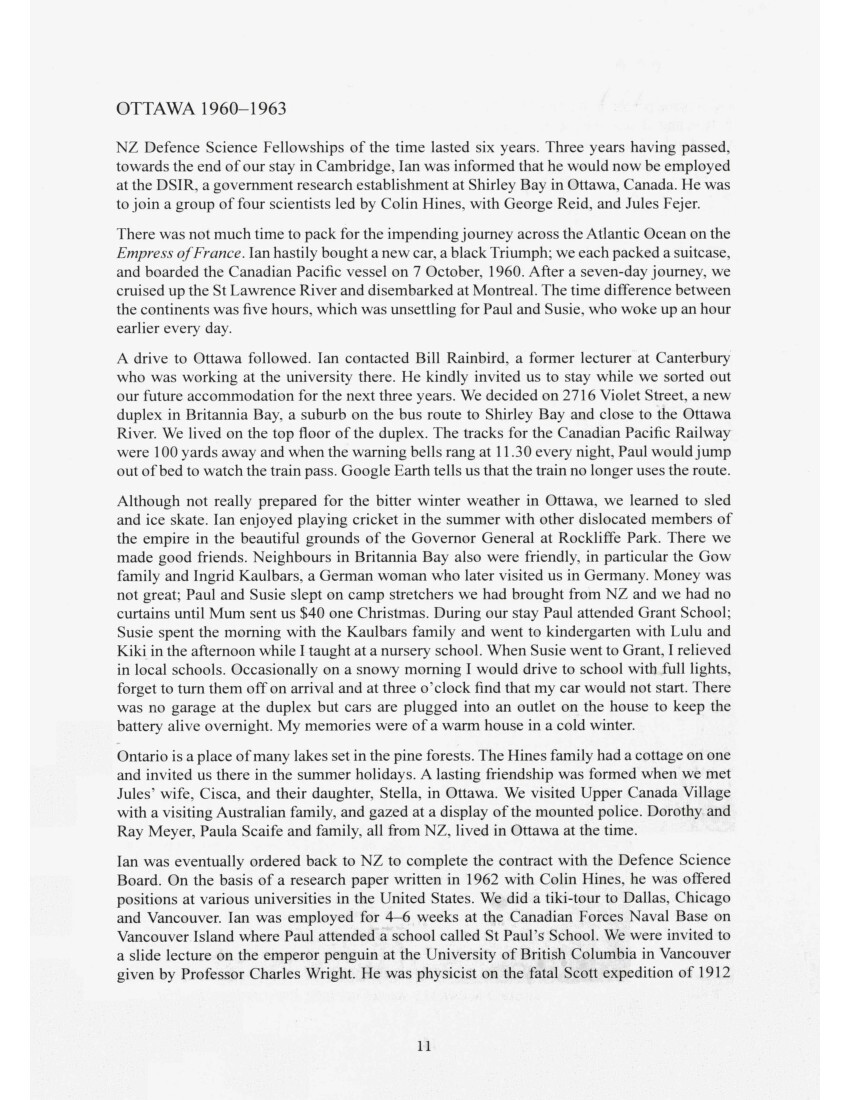
Page 12
and was the person in the search party who identified the tent containing the bodies of Scott, Wilson and Oates. We met up again with Sir Charles and his daughter Patricia when they moved to La Jolla.
In November 1962 we were given first-class tickets to travel to Auckland on the brand new P&O ocean liner SS Canberra, which was built in Belfast for the United Kingdom-to-Australia run. Nicknamed the Great White Whale, Canberra was later used to carry troops during the 1982 Falklands War and afterwards was a favourite cruise ship. She was dismantled in 1997. A stop was made in Honolulu, where I recall the draught of the ship causing the sand to swirl in the sea bed as we approached the docks. After an absence of five and a half years we arrived in Napier to spend Christmas with family and friends and stay for the next 5-6 months.
2716 Violet Street, Britannia Bay, Ottawa
Britannia Bay, Ottawa River
Paul hving [having] fun
Caring for kindergarten pet rabbit
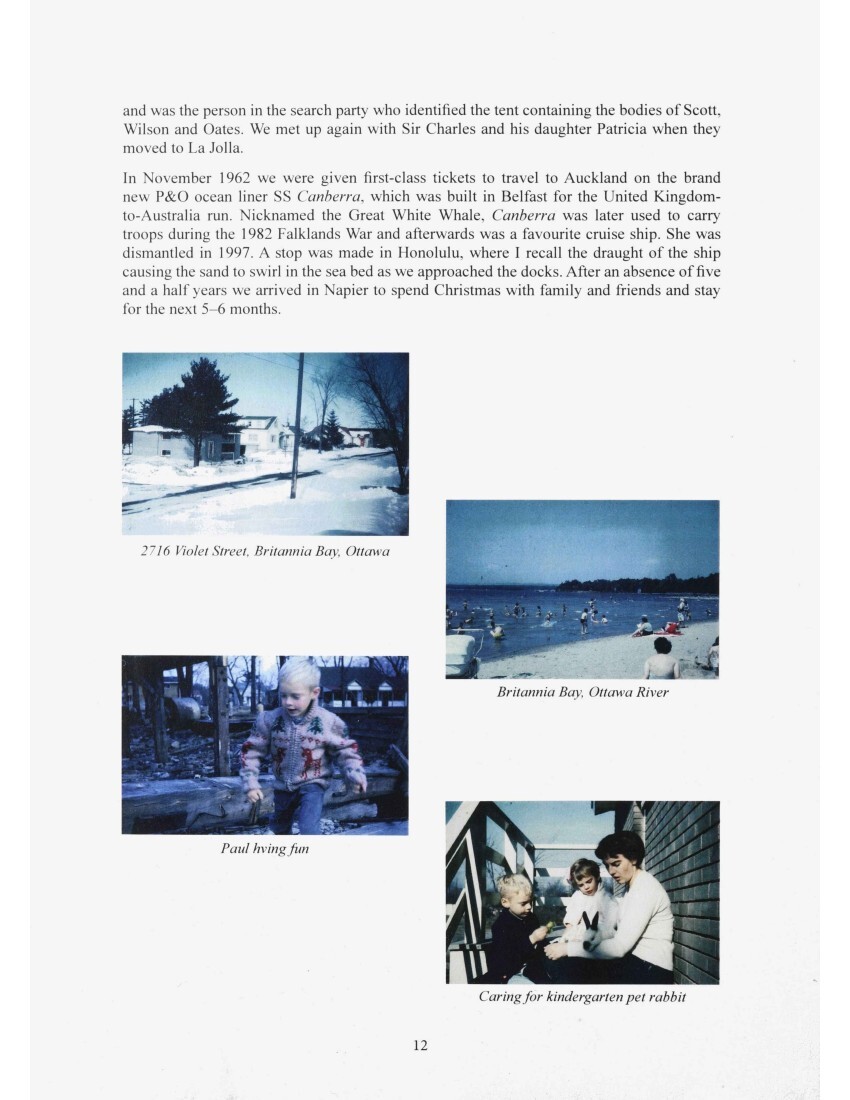
Page 13
NAPIER 1963
Ian was to complete the Defence Science bursary at Shelly Bay in Wellington, the site of a former air force base on the Miramar Peninsular. He fitted in playing as much cricket as possible for Hawke’s Bay and Central Districts. Our family fitted nicely into 29 Bedford Road with Ian’s mother, May, and it was lovely to have Ian’s grandparents across the road. I bought a car from the Didcotts across the road, in order to be mobile. Paul and Susie attended Marewa School, and time moved on to 14 April 1963, when our second daughter, Linda May Joy, was born in Bethany Home.
Queen Elizabeth and Prince Philip visited New Zealand in early 1963 and I had a close seat in the grounds of St Paul’s Church. At the time David Prebensen, who we knew from schooldays, was the Mayor of Napier.
While in Wellington and Napier, Ian considered the offers he had received and decided that he could further his interest in cosmic rays in the astronomy department at Cornell University under Thomas Gould, an interesting person and imaginative scientist. Ian flew to the US shortly following Linda’s arrival and I was to follow by boat later.
In order to obtain our visas, we were obliged to be vaccinated against smallpox and fingerprinted. This took place at the American Embassy in Wellington and was duly accomplished. The children and I sailed on the NZ Shipping Company SS Rangitane, for the second time, would you believe it, leaving Auckland on 7 September 1963. The route sailed was via Tahiti, Panama Canal, Kingston, Miami and Bermuda. I took Paul and Susie down the gangplank to walk around Tahiti, where the volcanic cliffs were spectacular and, in Panama, I was lucky to find the way back to the dock.
At Everglades, our luggage was off-loaded while we were still onboard, and was forwarded by train to Ithaca. Each piece was numbered, the larger ones being two cabin trunks, which my father had bought at McGlashan’s Mart. I bought a stroller in Miami, with which we could transport Linda. We disembarked at the island of Bermuda, a British territory to the east of North America. A friend from the boat joined us for a night to babysit while I took Paul and Susie on a tour where they fed sharks and turtles. We flew to Idlewild (now Kennedy) Airport at New York, and thence by Mohawk Airlines to Ithaca. Ian met us but I do not remember at which airport. Fortunately our luggage arrived intact.
Joy’s car outside 154 Nelson Crescent
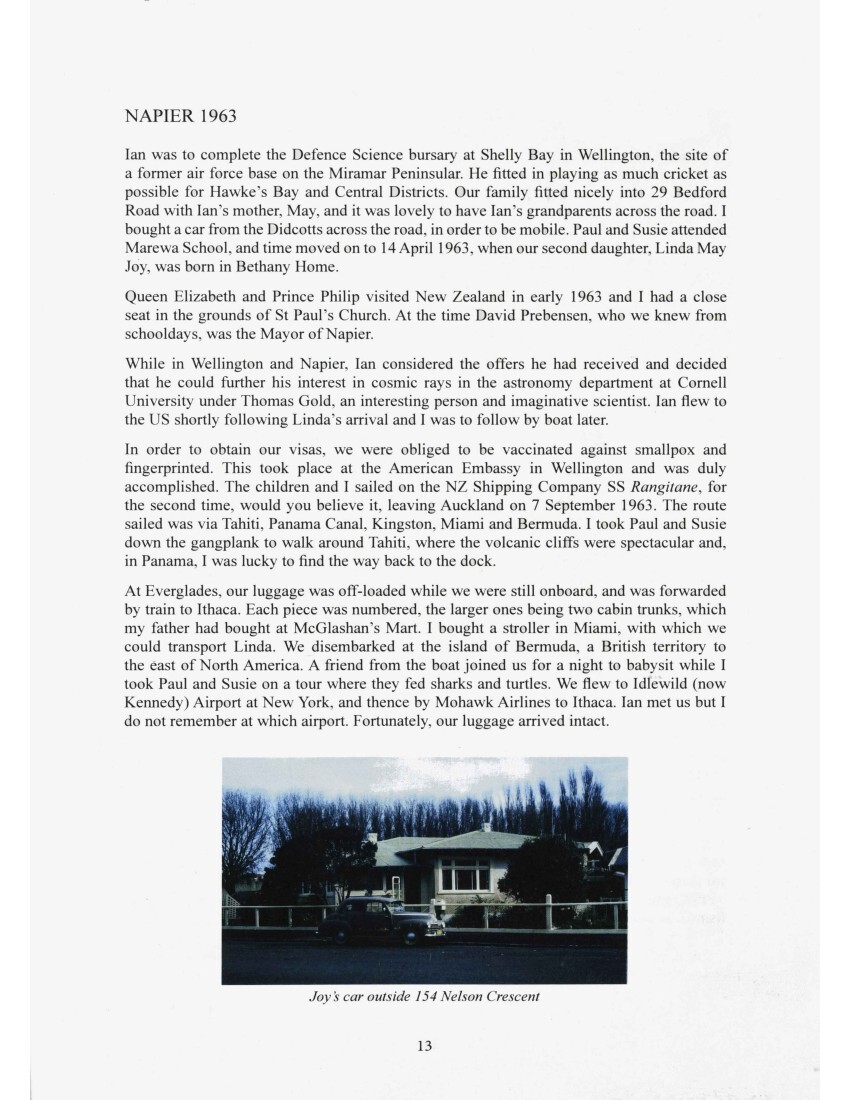
Page 15
ITHACA, NEW YORK 1963-1967
Ian had found and furnished an apartment for us in a suburb of Ithaca called Winston Court. It was on the third floor in a block of six already occupied by families whose husbands were studying or teaching at Cornell University. Everyone was friendly and we stayed one year only because on 29 August 1964, Robert Ian, our American baby, was born in Tompkins County Hospital. On that same day we moved along the road to a furnished house on Winston Drive, which was vacated as the owners (the Eisners) were on sabbatical leave. Our lovely neighbours were Leila and David Fisher with whom I am still in contact today.
Ithaca is situated at the foot of Cayuga Lake, one of the Finger Lakes in upstate New York. During the Ice Age, glaciers scooped out deep valleys, which later became lakes surrounded by waterfalls. Cornell University sits in beautiful surroundings, as do many universities in the US. We were accepted into the Gold’s group of partying friends and were actually at a party when we heard that president John F. Kennedy had died of a gunshot wound in Dallas (22 November 1963).
As we needed to move from the Eisner’s house we bought our own, an attractive cottage opposite Cayuga Heights Elementary School, 101 West Upland Road, costing about $30,000. Situated in an acre of wood, it was a two-storey house with stucco exterior and window boxes, a Cornell kitchen – fashionable then and now online – and four bedrooms on the second floor. The house came with a ginger cat called Pumpkin, which refused to leave with the former owner and always returned after taking him to his new home. We built a wooden deck looking out to the maple trees in the wood. Naturally the house was steam-heated by an oil furnace in the large basement. My friend Mairi Durie was staying with us at the time of the great New York power outage in 1967.
Paul and Susie attended the Cayuga Heights School across the road from our house and there were plenty of department parties for Ian and me to attend. Leo and June Gleeson, Australians, were also there. Tommy, his wife, Merle, and their three daughters, Lindsay, Lucy and Tanya, all became good friends and the girls were happy to babysit Linda and Robert. I believe that I took Paul and Susie to New York during that time as I recall visiting the grave of the late president.
While living in Ithaca, we often returned to Ottawa in the summer as Ian wanted to continue playing cricket. We would stay at lakeside camping grounds and always enjoyed the drive over the Thousand Islands Bridge on the boundary between the US and Canada. We would meet up with our Ottawa friends Colin and Kate Wells, and the Kaulbars family. A visit to the Corning Glass Museum – home to famous Corning table and cooking ware – was an interesting tourist spot close by. This prompted my continued interest in stained glass.
However, after four years in the Astronomy Department of Cornell University, Ian felt it was time to move on careerwise. The new University of California was being established in the village of La Jolla, in San Diego County. Henry Booker was also leaving Cornell for California to establish the Department for Applied Physics and Information Science (APIS). I need to add that Frank Drake, Carl Sagan and Ed Salpeter kept the department at Cornell lively after we left, building the telescope in Puerto Rico.
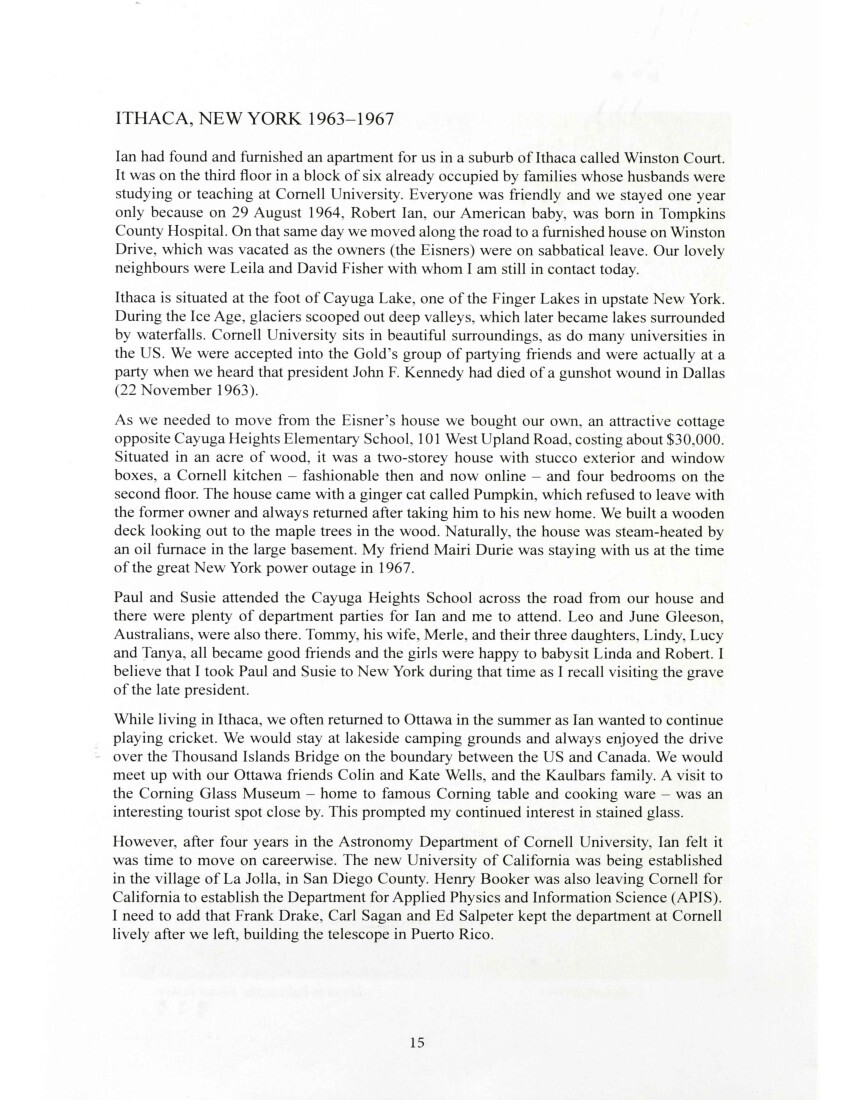
Page 19
LA JOLLA, CALIFORNIA 1967-1974
The newly established University of California was staffed ‘from the top’ – Nobel Prize winners and eminent scientists headhunted to teach in up-to-date conditions above the glistening waters of the Pacific Ocean. La Jolla had always attracted an exclusive intelligentsia. Gulf General Atomic, Scripps Institution of Oceanography, the Salk Institute, renowned for inventing the polio vaccine, were in the area. Jonas Salk and Francoise Gilot, former wife of Picasso, lived nearby. Theodor Geisel (Dr Seuss) with the ‘Cat in the Hat’ on his front gate, lived there – also Sir Charles Wright and daughter.
On arrival in La Jolla, a village in San Diego County, we rented a house near the campus, 101 Inyaha Lane. The large house was at the end of the street at the top of a canyon from which one could hike through the scrub to the sandy beach below – “if you were a mountain goat,” remarked Ian. I think we all tried it once.
Of course, our furniture and household effects had not arrived, but friends kindly supplied us with essentials such as beds and blankets. Robert was a three-year-old and Linda just over a year older. Paul later would attend Muirlands Junior High School and Susie would ride a bicycle to Torrey Pines Elementary School. However, it was time to have our own house again.
Surrounded by the Pacific Ocean and with a deep, dry hinterland, La Jolla offered a wide range of properties for sale – and prices. We settled on 7075 Neptune Place, 100 yards from Wind’n’Sea surfing beach and a short drive from the village and schools. The property consisted of two duplexes named The Garden Apartments, because each duplex consisted of two two-storey units, each with a tiled enclosed patio with plantings. We lived in the unit next to the driveway to the garages, and built a new bathroom on the ground floor with another bedroom above. We added gas central heating and found occupants for the other three units. The sun set over the Pacific, across the road, and we kept looking for the mythical green flash. Furniture, including our first piano, a Steinway, was all bought at garage sales and much is still with us.
Because many scientists came from other countries, I joined Newcomers to help their wives adjust to the US. Newcomers was run by Frieda Urey, wife of Nobel Prize winner Harold Urey. A boat ride to watch whales in the ocean was a favourite tour, especially for the women who were from Europe. I and another scientist’s wife who liked to swim, passed a course and taught swimming to students of La Jolla Elementary School. The use of private swimming pools in the community was arranged and it was a fun thing to do. I then taught swimming at La Jolla YMCA and stayed friends with other teachers for many years following.
Looking back now, I feel we were very fortunate to spend seven years in La Jolla, a suburb of San Diego: a city still with its ancient mission; a world-famous zoo, with the model of a gorilla that was used in the film King Kong, at the entrance; Sea World, where one can view performing dolphins; beautiful Coronado Beach, with its historic hotel; the Naval Base, with the Star of India tied up at the wharf, – all places to visit and enjoy. Plus an international airport, where plans land and take off not far from the city streets.
Driving north from La Jolla, through the picturesque seaside villages of Del Mar, Oceanside and Ensenada, one eventually arrives in Anaheim, home to – guess what – Disneyland, a theme park of wonderful attractions, entertainments and rides for people of all ages. We met
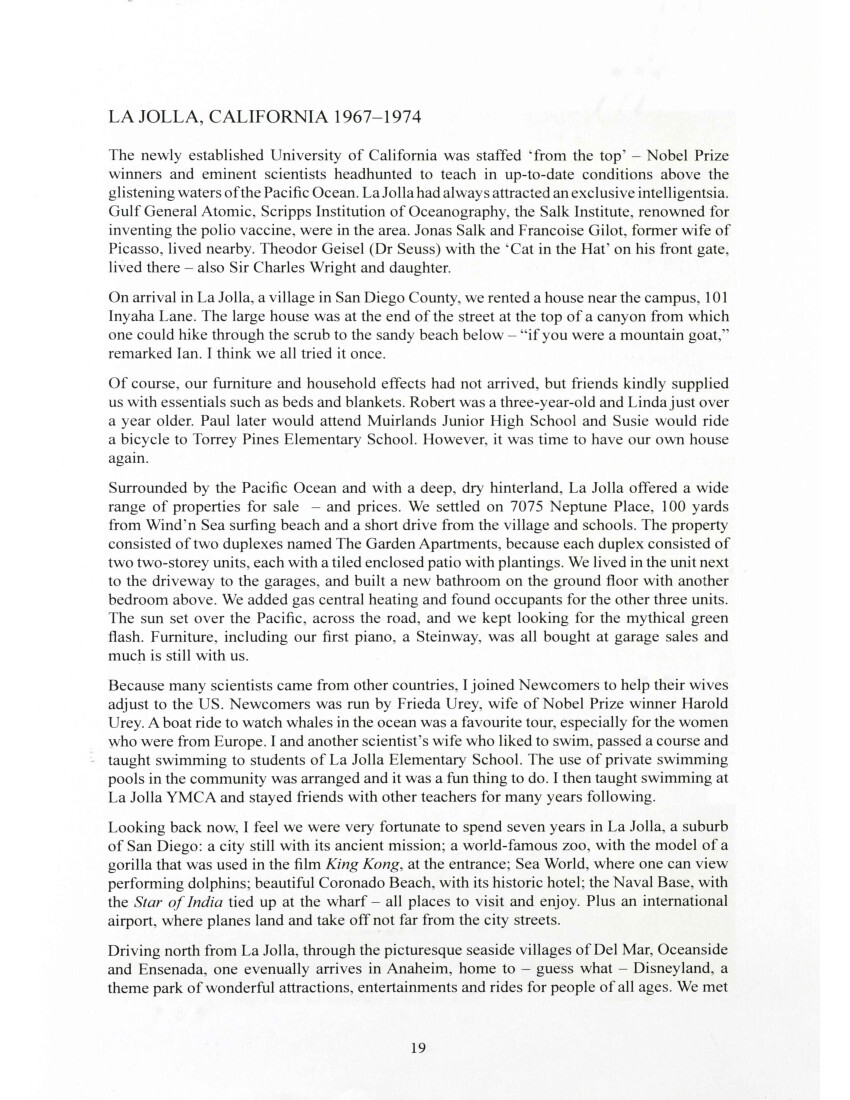
Page 20
Winter at the beach
7075 Neptune Place
Outside
Inside apartment
At home
Leaning to swim is fun in the Red Cross backyard swim program. Taking advantage of the instruction are, left to right, at pool’s edge, Grace Zimmerman, 6, Marie Bozetti, 7, Emily Fierer, 6, John McDowell, 8, Linda Axford, 9, and Robert Axford, 8. That’s Mary McDowell, left and Carol Ward, both 5, in the water. Instructors are Laurie Martin, left, and Joy Axford.
Photo: La Jolla Light
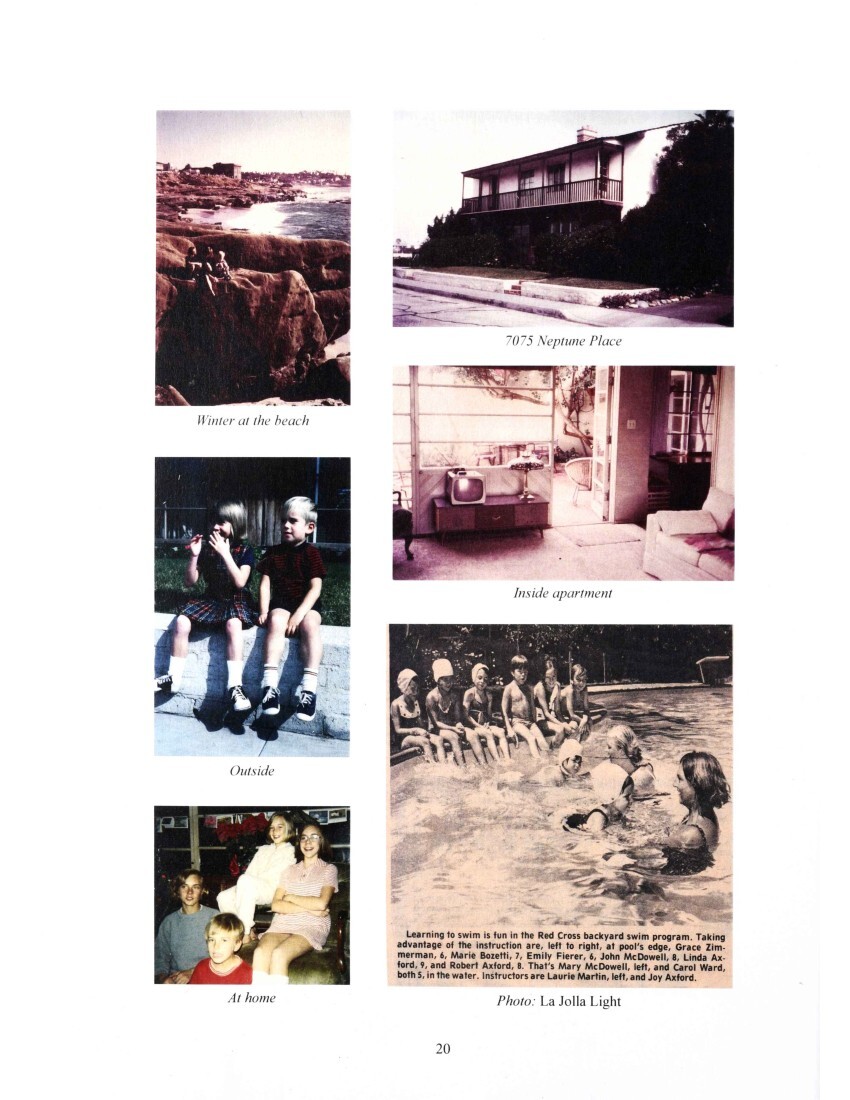
Page 21
my Ardmore friend Margaret with her husband, David Harrop, and their family there once. I believe we took May there. Not far from Anaheim is Los Angeles, home to the big film studios, with the imprints in the concrete on the Boulevard and the HOLLYWOOD sign on Beverley Hills.
A one-hour drive northeast from LA is Pasadena, site of the Jet Propulsion Laboratory, a NASA centre for space exploration, which was directed from 1954 to 1976 by Bill Pickering, a New Zealander, who also has a mountain named after him in the Kepler Range. We met Bill and his wife at a special New Zealand weekend in Palm Springs, to promote tourism I think. There was a nice photo in the newspaper along with the article. This is the area of Art Deco architecture initiated by Frank Lloyd Wright, glorified in the Californian bungalow, and promoted in the rebuilding of Napier following the 1931 earthquake by architect Loius [Louis] Hay, and revered still.
The name Art Deco originated in France between the two world wars. In 1997, with Robert and Helen McGregor and other members of Art Deco Napier, I attended a world congress in Los Angeles and we were taken to wonderful sites including the famous beaches of Santa Monica and Venice. Napier had a world congress two years later.
One drives everywhere in the US. An hour south on the motorway and you reach the Mexico border at Tijuana, home to the Tijuana Brass. It was my pleasure to do this and I took every friend or visitor there to walk the streets and have a meal at a prescribed restaurant. It was considered unwise to buy food from a street seller.
We spent seven happy years living on Neptune Place, socialising with other members of the department and learning how to cook Mexican food. We bought a beautiful green Chevrolet Impala, which I enjoyed driving, especially down to Tijuana. It was the 60s – time for parties, protests, politics and pop music.
Robert’s birthday at the beach
Out to celebrate Thanksgiving
Wind’n’Sea, La Jolla

Page 23
GERMANY 1974-1982
In 1974 Ian was involved in a committee to peer review the closing down of the Max-Planck-Institut für Aeronomie (MPAe). The institute operated in former barracks in a village named Lindau (later Katlenburg-Lindau) in Lower Saxony for the study of the ionosphere and magnetosphere. Directors Dieminger and Pfoetzer were about to retire, and because of the growing importance of space science, Ian was invited to become a scientific member of the Max Planck Institute to advise on the future of MPAe. However, the position of director was now available. Ian applied for this position and was duly appointed managing director of MPAe. What could the family do?
The duplexes on Neptune were put on the market and duly sold, as was some property we owned in La Jolla Shores. There was much interest in APIS regarding his decision. The Americans thought we were crazy going to Germany – the war, Jews, the concentration camps etc., etc., were still remembered as you can imagine. But we were going. Paul was to stay in La Jolla for a while with Asoka – Susie was already at Massey University in NZ. Some German language lessons were arranged at home to prepare us for the change and household belongings were packed or sold.
There is evidence that a brief family visit to Napier took place before leaving La Jolla for Germany. My parents were to celebrate 60 years of marriage on 5 February 1974, and a photo shows that Joy, Susie, Linda and Robert were present. A local newspaper article notes that paper serviettes, with the date on, were brought from California for the event and actually, I still have one.
Joy, Jim, Linda, Robert, Kate, Susie in Napier for the Diamond Wedding celebration
The serviette
Visit over, Ian, Joy, Linda and puppy Charlie, and Robert eventually emerged from a train in a town, Northeim in Germany. I believe we were met by Andrew Matthews and Jim McKenzie who transported us to a house on the outskirts of the village Lindau. We were to discover the Harz Mountains and the great border which divided East from West Germany close by.
We lived in the large house built especially for former director Herr Dieminger and enjoyed the fish pond, the swimming pool, the large basement for storage, the deck and steps to the rock garden, the raspberries on the vines, as well at the two helpful gardeners. We bought bedroom furniture and other amenities, including a beautiful Mercedes Benz automobile. I
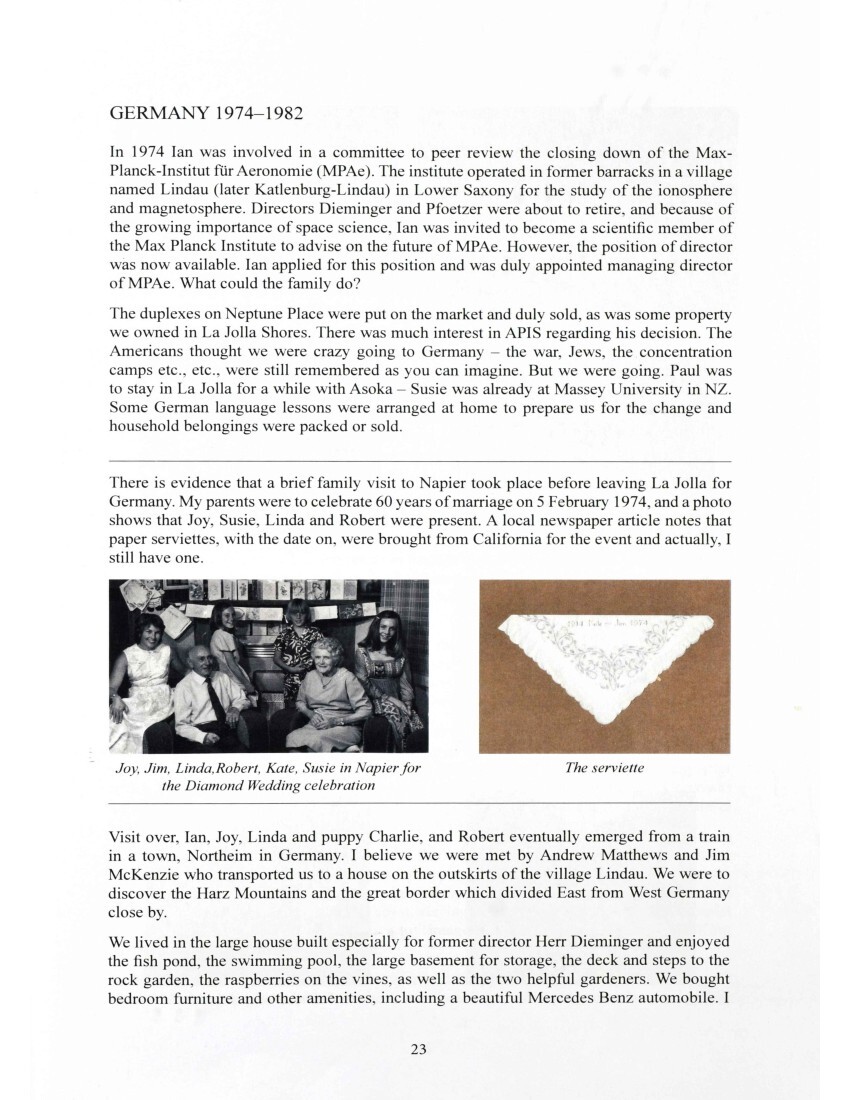
Page 25
was cleaning it outside the garage one Sunday and was told by some villagers walking past that it was wrong to work on that day. The custom was to attend church in the village in the morning and take a walk in the afternoon. I did not offend them again. Our US driving licences were still valid for a year and when it became necessary, I had a lesson and passed the test at Stockport, the closest town.
We were welcomed into the family that was the institute. Although we did not speak their language, many of the scientists were fluent in English, and they could not understand why we would leave sunny California for Lindau. In what seems now to be a short time, many foreign scientists, colleagues or friends visited and worked there. Among them were Vytenis Vasyliunas, Jules Fejer and his wife Ruth, Carl and Mary MclIlwain with son Craig, and the Greenwald family. Many came from New Zealand such as Andrew and Wendy Matthews, Harry and Natalie Whale, Gordon Keys and wife Roma, Bill and Sylvia Allan, the Dowden family from Dunedin. I could go on and on forever.
Tidy accommodation in former institute buildings near our house was available for visiting scientists – so many that the Germans called the area a ghetto! We made many friends over those first eight years. The local kindergarten and primary school were happy to welcome children from other countries. Visitors enjoyed participating in traditional cultural events, especially the annual Fasching parties and Schutzenfest.
As in Ottawa, the seasons were clearly defined. In winter, snow tyres were put on the car for safer driving, especially as I was taking children to school at 7.30 in the mornings. We went sightseeing in the Harz mountains in the weekends. Goslar, with its heritage buildings, Braunlage. a resort with a gondola up the high peak are names that spring to mind. I twice took Linda and Robert to a skiing resort in Switzerland, recommended by Carla Lohmann, visiting them in Erlangen on the way back. There was always a visiting scientist available to stay in the house and look after Charlie. He loved jumping over heaps of snow when out walking.
I was hoping to find somewhere south to go in the summer when the wife of a Portuguese scientist said we could use their apartment at Praia da Rocha, on the Algarve coast. We took their offer and spent two enjoyable summer holidays there, finding it most interesting as the Portuguese did beautiful crochet and handwork while sitting on the beach.
Paul visited often, also Susie – once with Sue Brown. I drove them to Bavaria and they saw Neuschwanstein castle. Dachau and other places of interest. My friend Jill Caswell visited and we went north to see the wall (Danewirke) built between Denmark and Germany after which Dannevirke in New Zealand was named. Susie usually came here in the Christmas holidays: I always picked her up at Frankfurt Airport. Once we had a trip to Amsterdam to see the canals and the Rembrandt museum, and took Charlie too.
Linda’s horse. Ferry, was stabled in nearby Berke where she daily cared for him and we enjoyed many horse events on Sundays. Linda attended a horse camp on Bodmin Moor one summer with other German girls. I drove her over and, while she attended the camp, Robert and I toured the Devon and Cornwall coast, staying at campgrounds and doing the tourist spots. After we picked her up, we drove to Tintagel, the castle where the mythical King Arthur was supposed to have been born.
Back in Lindau. Robert needed better transport and swapped his English bicycle for a moped. He and Linda made plenty of friends there, mostly children of visiting scientists, and picked
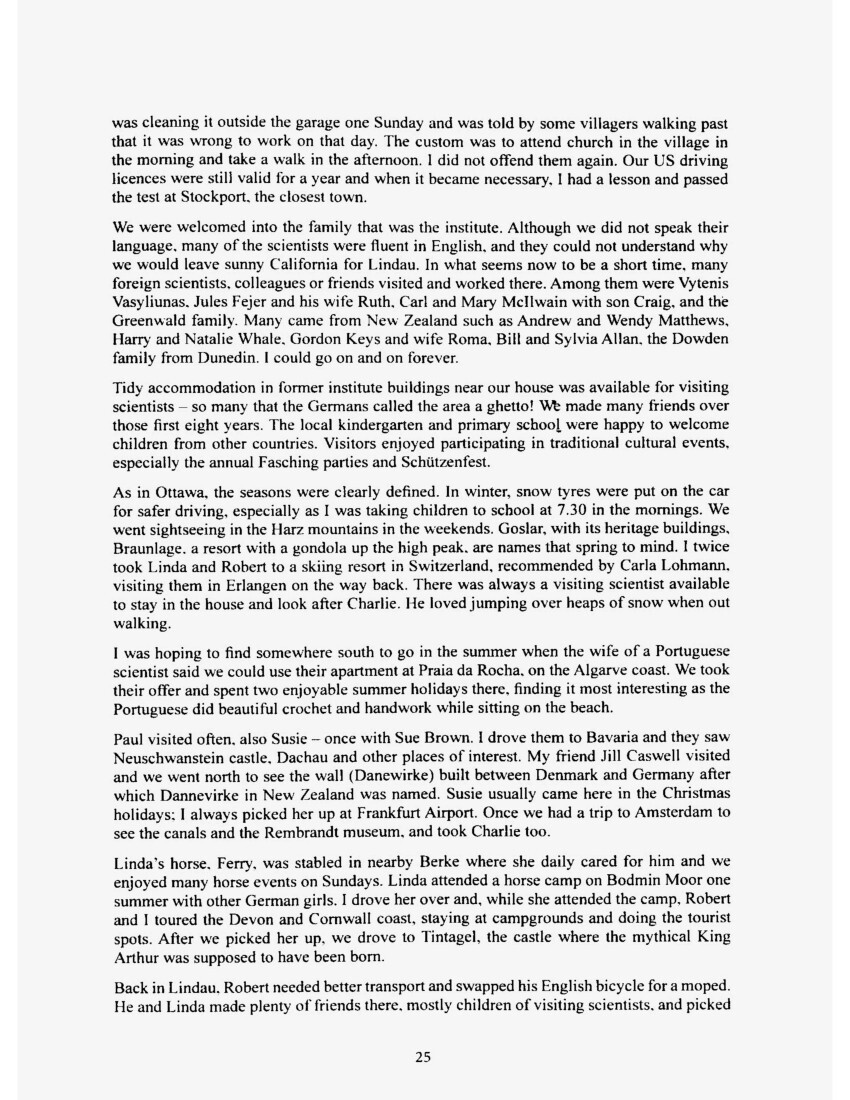
Page 27
Ian took up the language well – better than me, even though I attended a Goethe course in Gottingen. As I improved, we held conversation evenings in our house later to help newcomers with the language. We all enjoyed the time we spent living in Lindau from 1974 to 1982. Everyone was pleasant and countryside green and peaceful.
After five years in German schools, first at the middle school in Katlenburg then the Gymnasium in Northeim, Linda and Robert felt they would like to see their La Jolla friends again. Carl and Mary McIlwain had offered us their house for accommodation, so we flew over and met my sister Jean and niece Fiona there. We showed them around, drove them to Tijuana and enjoyed their company before they took a tour to Los Angeles.
In 1981, Linda spent some months in Los Alamos in the US, the reason being that she would need to achieve a certificate recognised by the universities of New Zealand to study when returning the following year. She was kindly hosted by the Feldman family, as the girls had been friends when in Lindau, and attained the document.
However, during our stay we experienced a couple of unusual events. There was a significant flood one year when the Rhume overflowed and swamped the village. Our basement was immersed and the cabin trunks, which held many personal belongings and paper material, were not able to be saved.
The other event took place one afternoon when I was looking out the dining room window and sighted a small plane coming down on institute land. We learned afterwards that the American pilots ejected safely and many ideas and myths circulated, based on the proximity of the crash site to East Germany.
Ian chipping away at the Berlin Wall
Joy with the Berlin Wall in the background
Ready to leave Germany
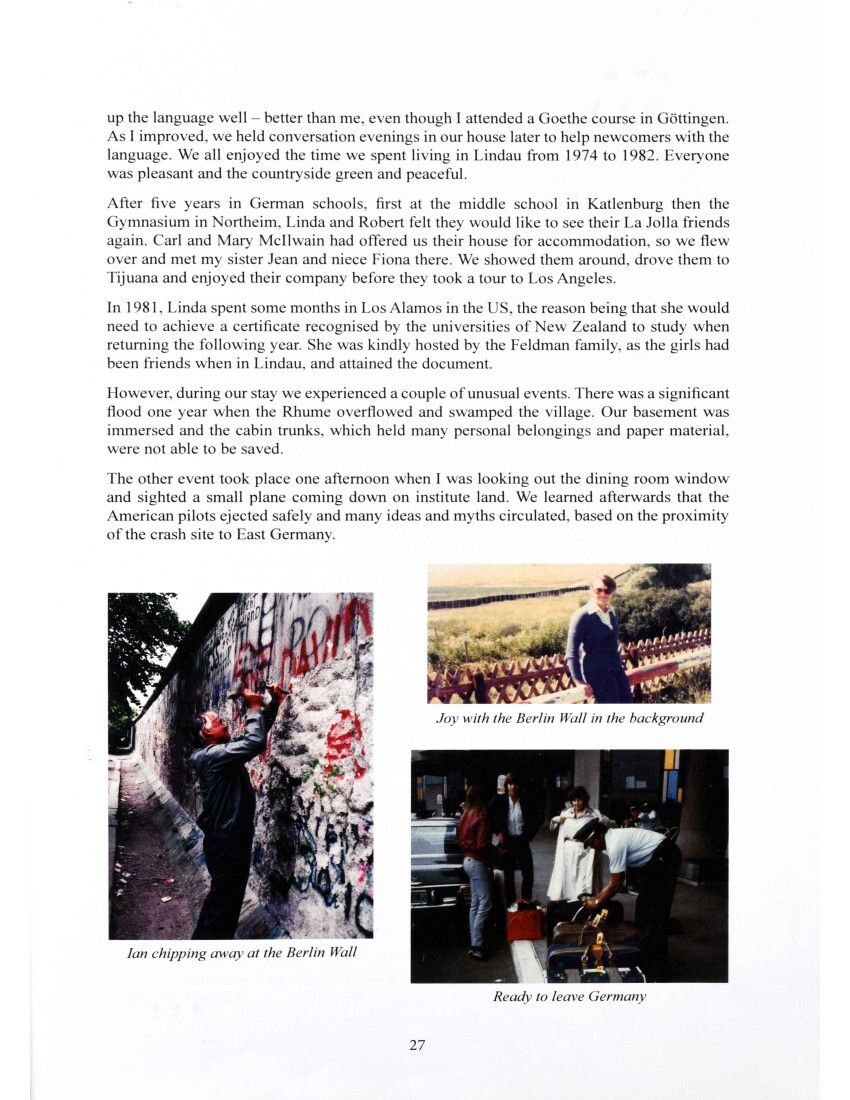
29
BACK TO NEW ZEALAND 1982-
Ian was due for leave after eight years at MPAe and we were informed that the position of Vice Chancellor at Victoria University was advertised. He applied and was successful so we each packed a suitcase and flew back to New Zealand to 12 Kinross Street in Kelburn, Wellington. We had forwarded enough furniture, mainly for bedrooms, our piano etc. to install in this house situated next to Anderson Park and the botanical gardens, within walking distance of the university and Lambton Quay. We were amazed to find a cool store under the house as we had brought ‘our cellar’ of Germany wine with us.
Linda and I enrolled for our degrees, and Robert photographed the production Waituhi. Ian spent three years planning improvements to the physical appearance of the campus, in particular saving the historic Hunter Building from demolition, and a redevelopment of the marae. Sadly, my father, Jim Lowry (15 May) and Ian’s mother, May Axford (3 April) both passed away in 1983, but we were fortunate to be present at their funerals, held in Napier. I played the organ at St Paul’s church for May’s service.
We all enjoyed living comfortably in Kinross Street and led a busy life in the capital city. I loved studying for my BA in Music and German, making many friends as well. Ian returned to his job at MPAe in 1985, so we looked to buy a family home in Napier. On a visit to Napier Boys’ High School one December, he noted a large house advertised by Cox Realty as a ‘Gentleman’s Residence’ on Napier Hill near the Girls’ High School and made an offer. I joined Ian the following weekend, because we were needed at NBHS Prizegiving, and we bought the house at the asking price of $125,000.
Linda and I completed our studies and graduated from the University of Victoria, Linda a BSc in 1986 and Joy a BA in 1987. We both returned to Napier while many improvements were made to the house on 2 Gladstone Road. Linda was fortunate to be employed by the recently established aquarium, feeding the sharks in the big tank. Robert, now a music addict who had toured and recorded with a band in Wellington, spent a year at the Musicians Institute in Los Angeles, 1988-89.
Paul worked as a mechanical design engineer in England and at the institute before moving back to the San Diego area in the US, then eventually to Napier. Susie completed a BSc degree in Dunedin, then studied industrial design in Sydney, where she met Sandy.
I heard that the Rudolf Steiner School in Hastings was in need of a music teacher, so I applied and was given the position. I enjoyed the other teachers and the school culture based on Anthroposophy for one year only. The school, Te Taikura, is now incorporated into the state system.
I then volunteered to help the librarian in the local museum and when the position became vacant I was appointed on a permanent basis. Genealogy is a popular pastime and the collection of archives held there were well sought after. I spent many happy house working in the library until I was told by a director to leave on my 65th birthday. Naturally, I maintained contact and my interest in genealogy has produced Our Lowry Family in New Zealand, published by Brebner Print in 2015.
We had a fun trip to Sydney in July 1992, when we were escorted by a local pipe band to a cottage on Bateman’s Bay where daughter Susie (Suzanne) took wedding vows with Sandy (Alexander) McNeil.
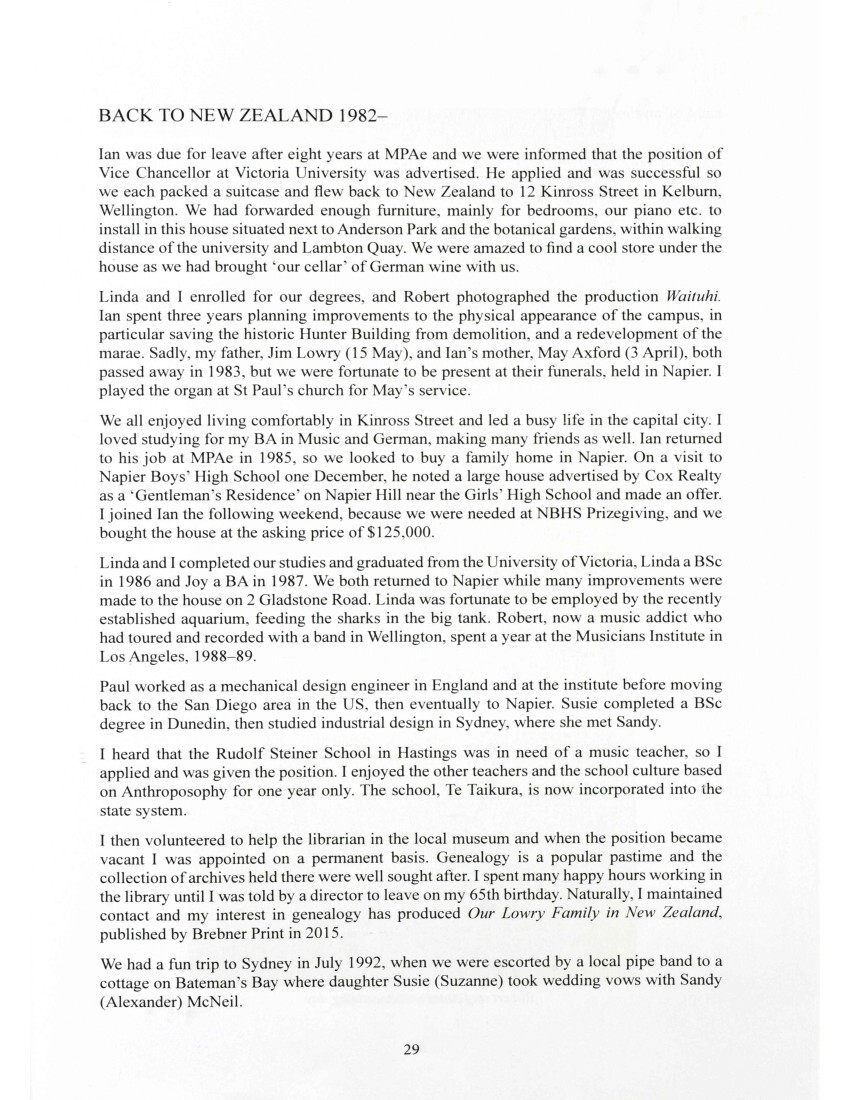
Page 31
In January 2004, son Robert married Antoinette Pick under the lovely redwoods on Te Mata Peak. A reception was held in a marquee on the lawn at 2 Gladstone Road.
Following his retirement in 2001 from MPAe in Germany, Ian filled professional positions in several institutions in the US and Japan before returning to Napier, where he became involved in a variety of interests – not all scientific. Unfortunately, he was diagnosed with bowel cancer in 2007, but was able to recuperate in his home after treatment in hospital. He passed away at home relatively peacefully on 13 March 2010.
After spending ten years living alone in our home, I accepted the offer of a serviced apartment at Princess Alexandra Retirement Village in Ahuriri and, aided by Cox Partners, sold our house in two days. I write this after having recently celebrated 90 years, with our four children, abiding by Covid restrictions, in daughter Linda’s beautifully decorated home on Selwyn Road in Napier. I am grateful for all family members and wish them peace in the years to come.
Ian and Joy on the deck
Ian and PM Jim Bolger
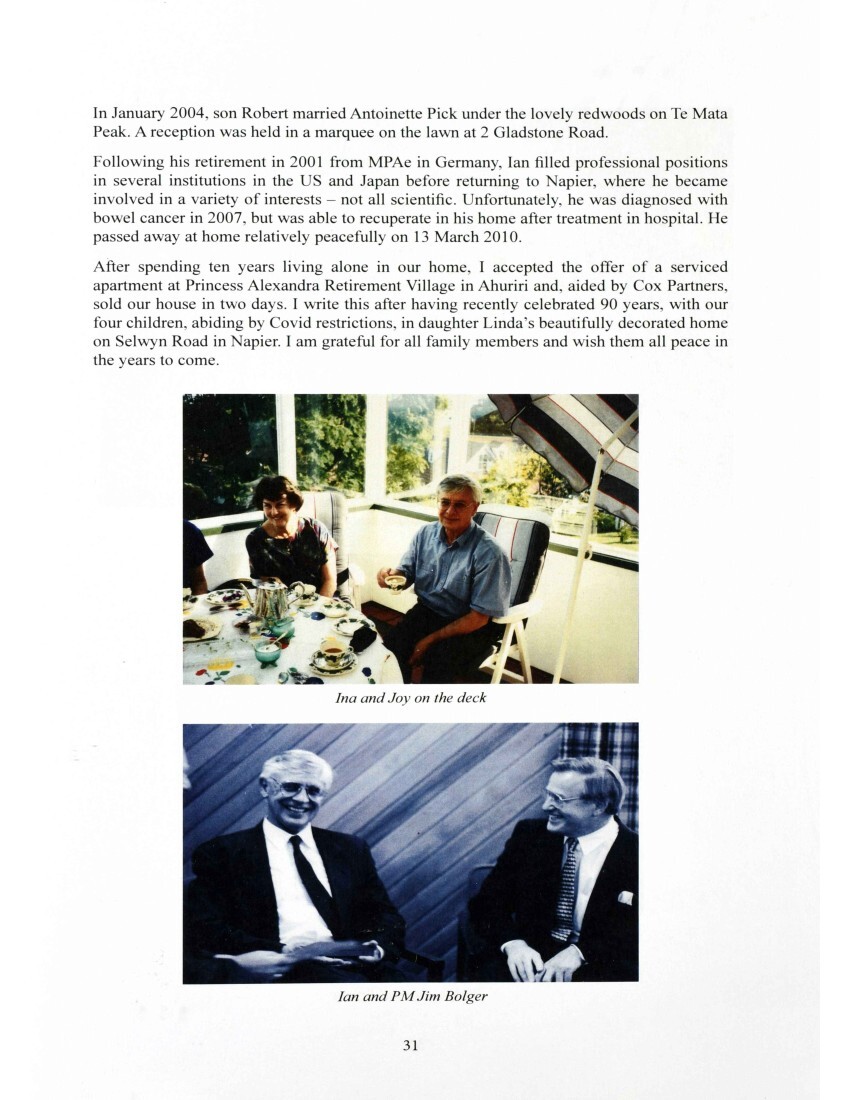
Page 33
JOY’S POEM
This is Joy’s Poem, which she composed in 2012 and read to Josephine and Elizabeth at their birthday luncheon at Off The Track, Havelock North.
When the twins were born in 1935
How were their parents to survive?
But they grew up fast and now are here
To thank Kate and Jim for loving care.
They ran, they jumped and climbed every tree.
Fingers twinkled on piano, violin and typing key.
They danced and skated and swam in the swell
And often came top of the class as well.
Kate and Jim now look down from Heaven.
Our girls look fantastic at seventy-seven.
Their lives are still busy and full of fun.
What a good job we all have done.
Elizabeth, Joy and Josephine

AFTERWORDS
The above narrative describes the numerous times the family shifted house while Ian pursued a remarkable career in astrophysics. This is portrayed in detail in the excellent biography written by William Allan and published in the Biographical Memoirs of Fellows of the Royal Society in 2013.
Although the process of moving was often tedious, family members made many friends and enjoyed the company of wonderful people. We all had exciting and fantastic experiences in many countries, something which would not have occurred had we stayed in New Zealand.
I am most grateful to my friend Val Thompson for her assistance in the presentation and the printing of my memoir. I met her by chance recently and she was pleased to help.
Lady C Joy Axford
S A 305
Information withheld
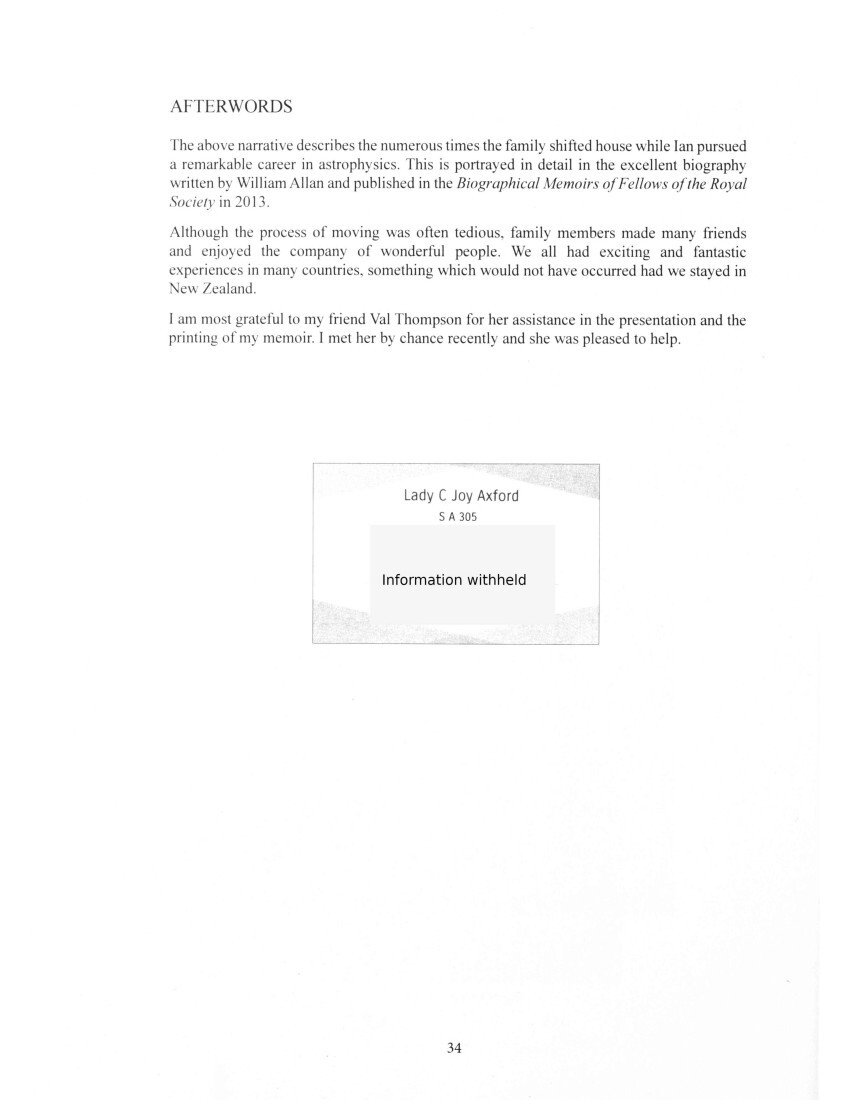
Non-commercial use

This work is licensed under a Attribution-NonCommercial 3.0 New Zealand (CC BY-NC 3.0 NZ).
Commercial Use
Please contact us for information about using this material commercially.Can you help?
The Hawke's Bay Knowledge Bank relies on donations to make this material available. Please consider making a donation towards preserving our local history.
Visit our donations page for more information.
Subjects
Format of the original
Booklet (9-32 pages)Date published
22 July 2022Creator / Author
- Lady C Joy Axford
People
- Antoinette Axford, nee Pick
- Lady C Joy Axford
- Catherine Suzanne (Susie) Axford
- Ian Axford
- Jack Axford
- Linda May Joy Axford
- May Axford
- Paul Ian Axford
- Robert Ian Axford
- Prime Minister Jim Bolger
- Jean Lowry
- Jim Lowry
- Kate Lowry
- Melva Lowry
- Josephine Lowry
- Elizabeth Lowry
- Robert McGregor
- Helen McGregor
- Reverend McKenzie
- Alexander (Sandy) McNeil
- Miss McPherson
- Stan Pearse
- Bill Pickering
- David Prebensen
- Jim Thompson
- Val Thompson

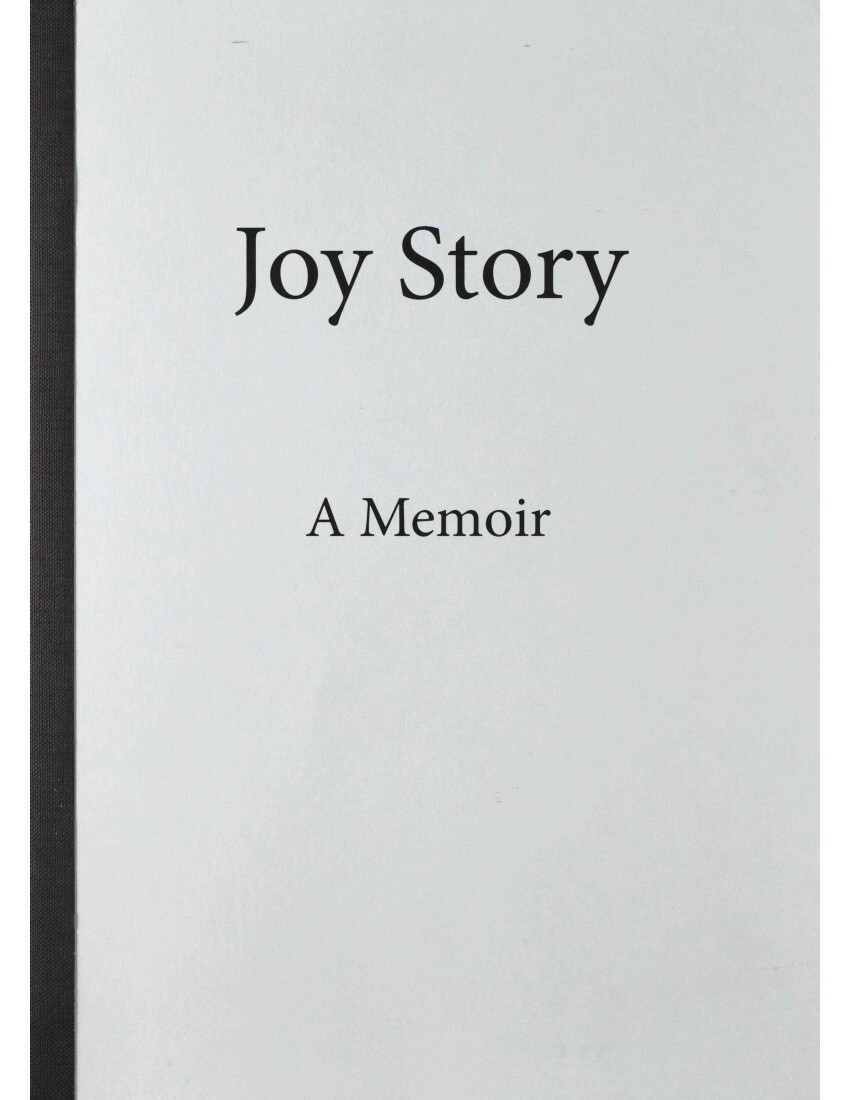
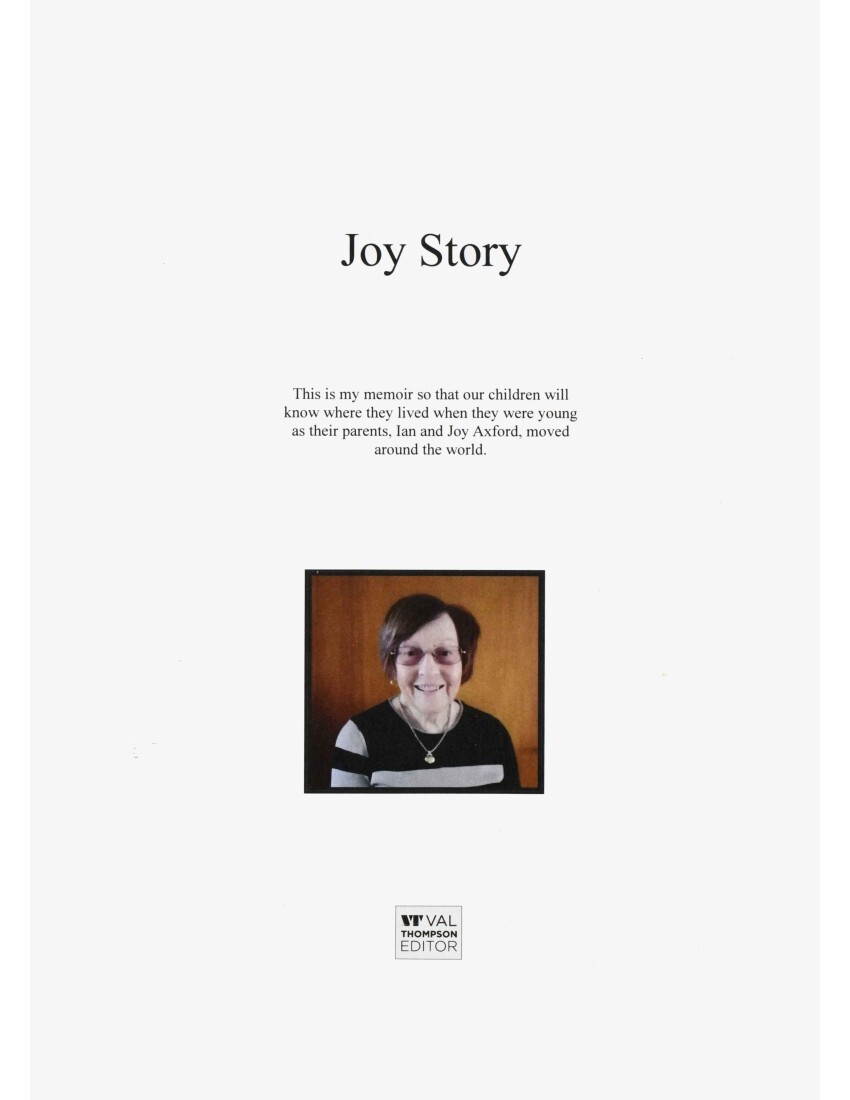
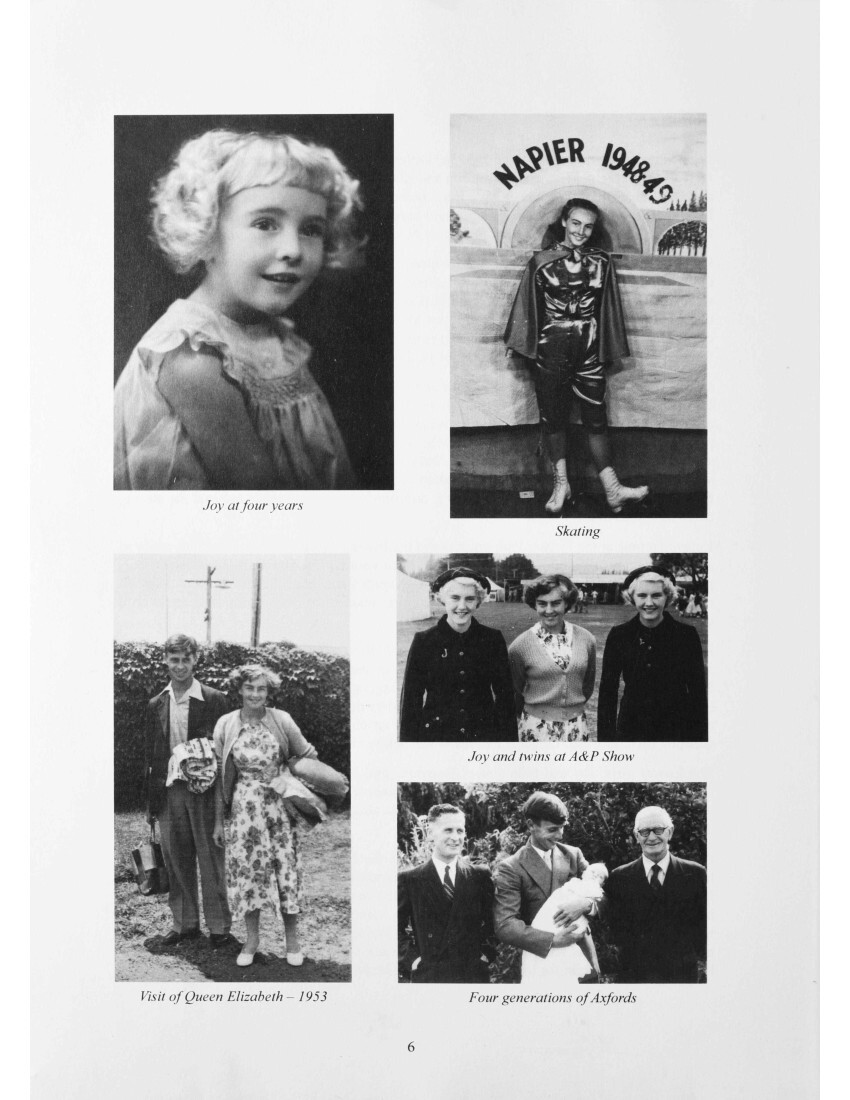
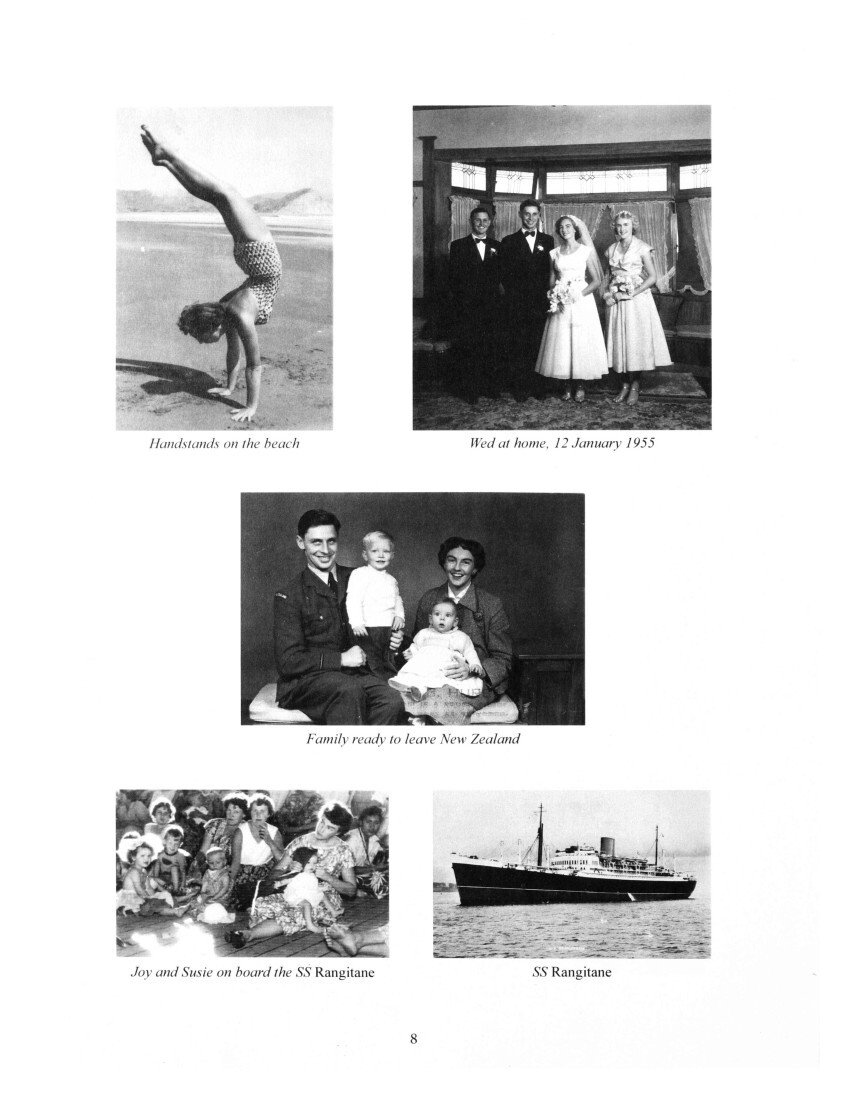
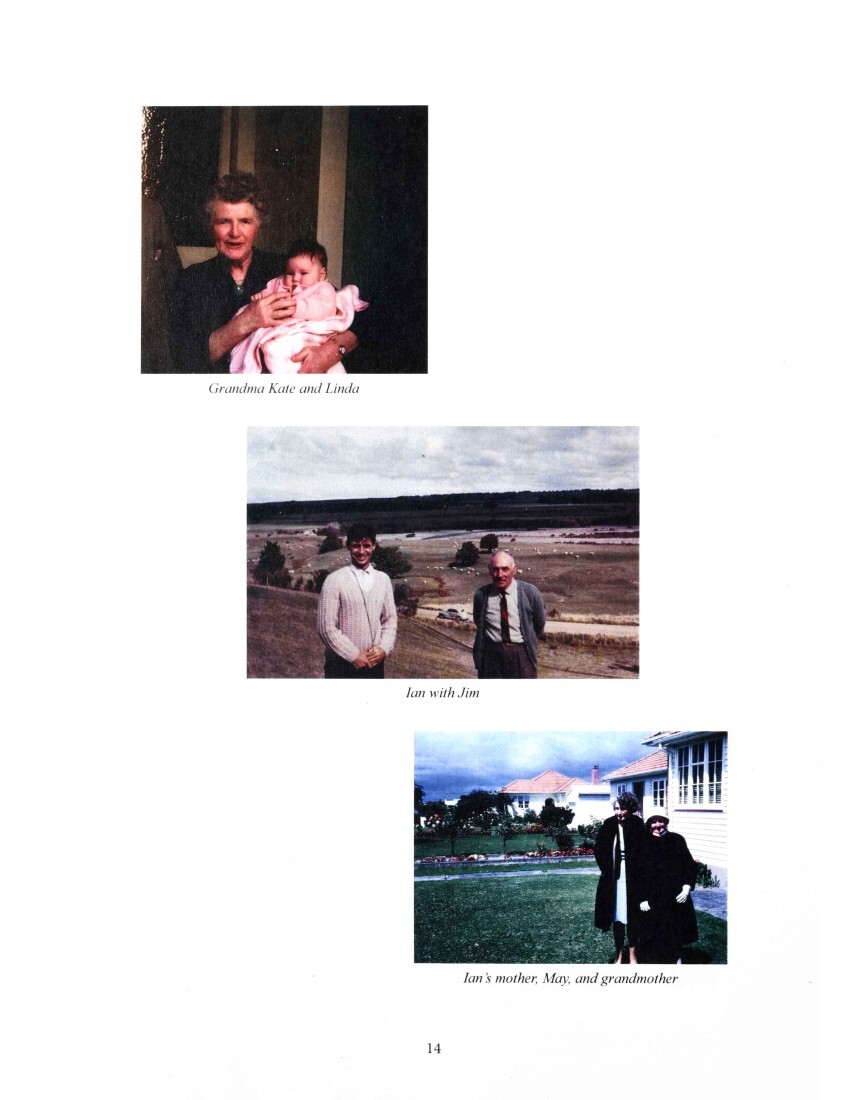
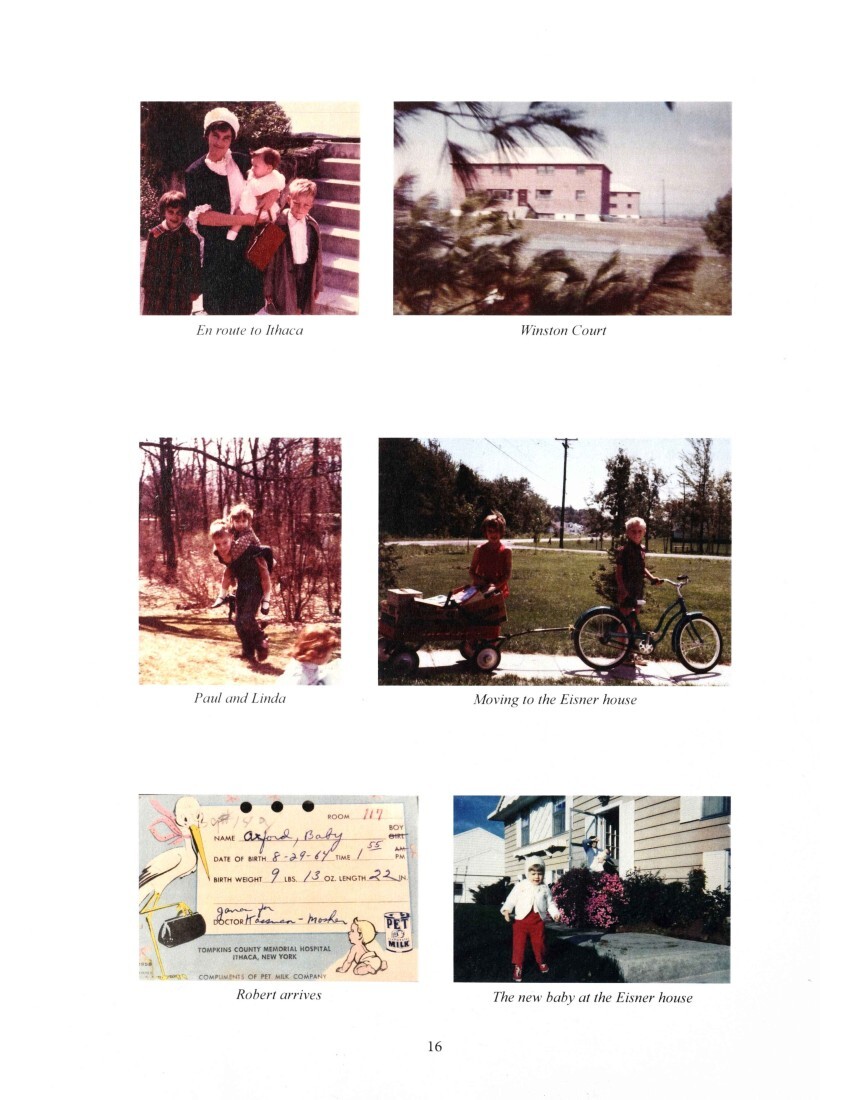
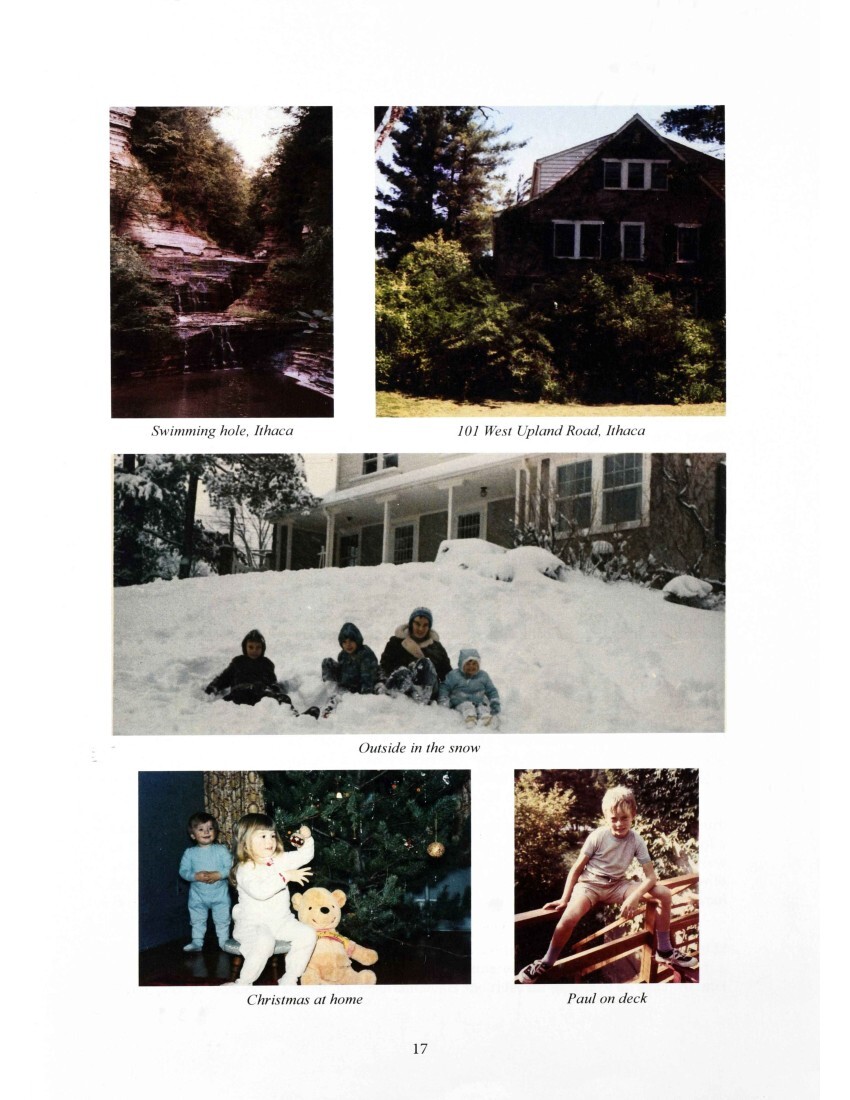
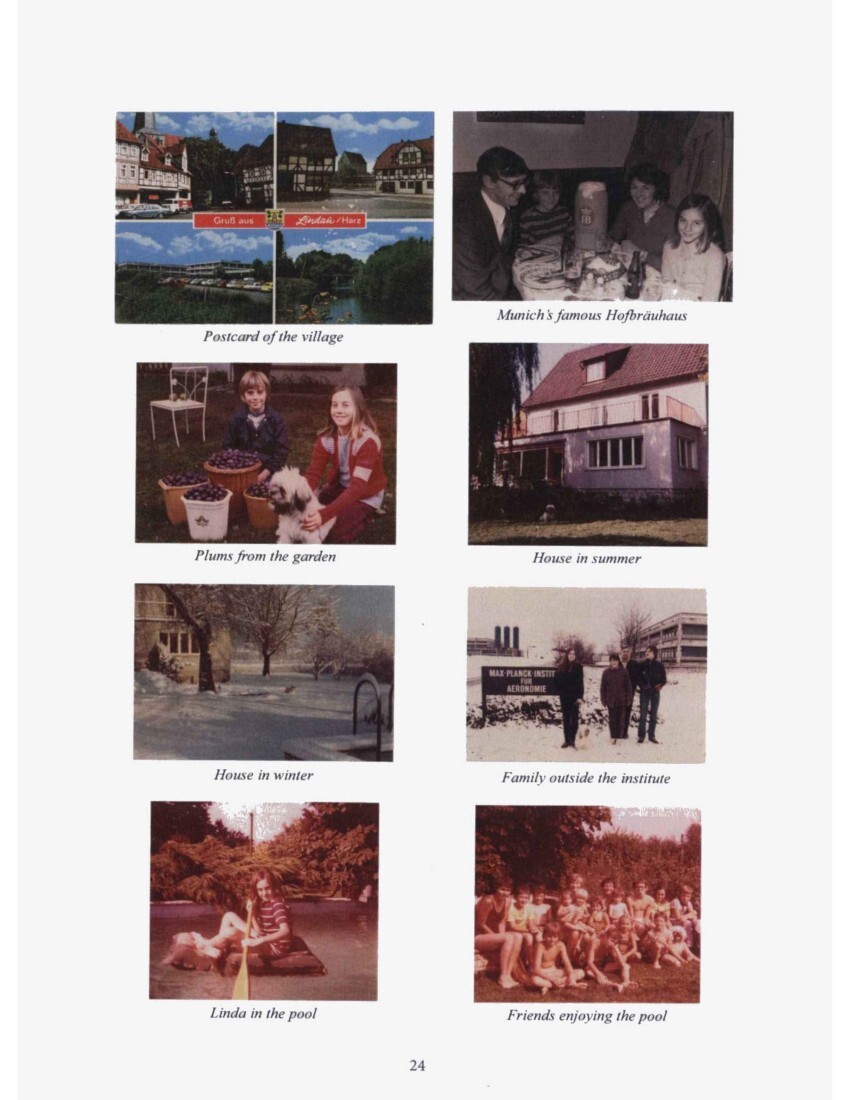
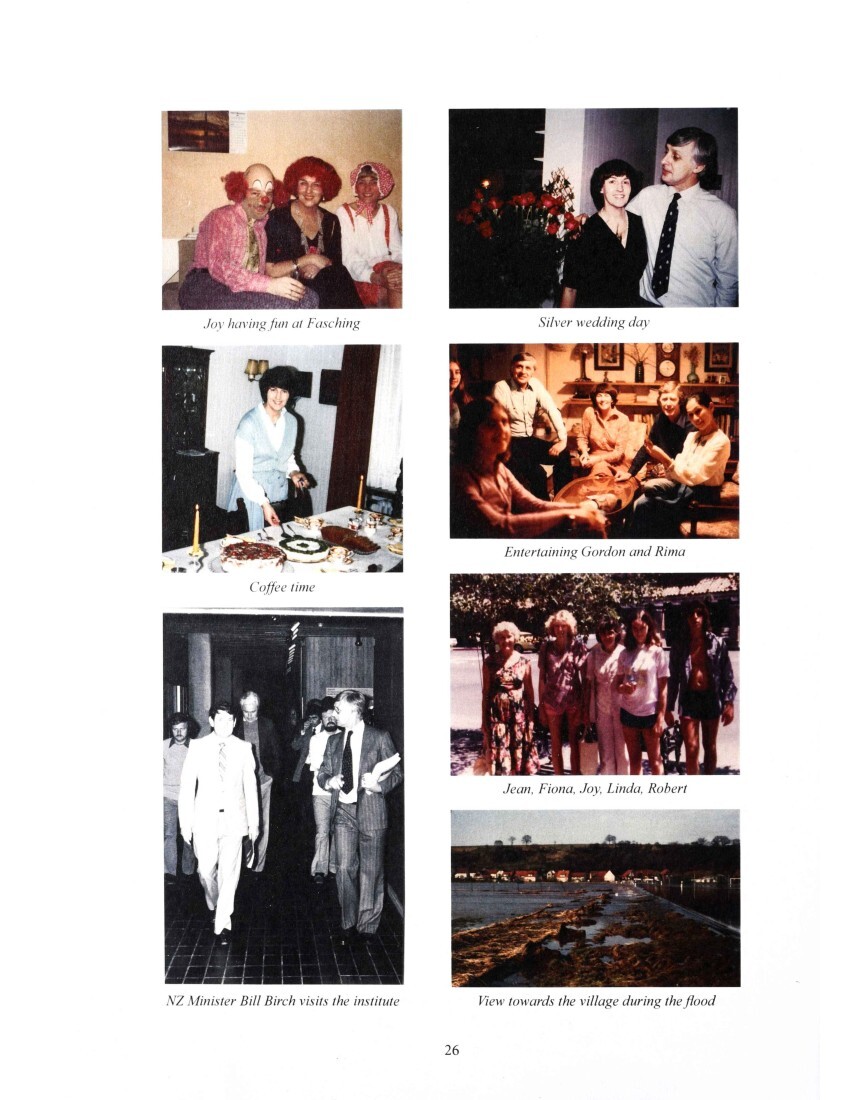
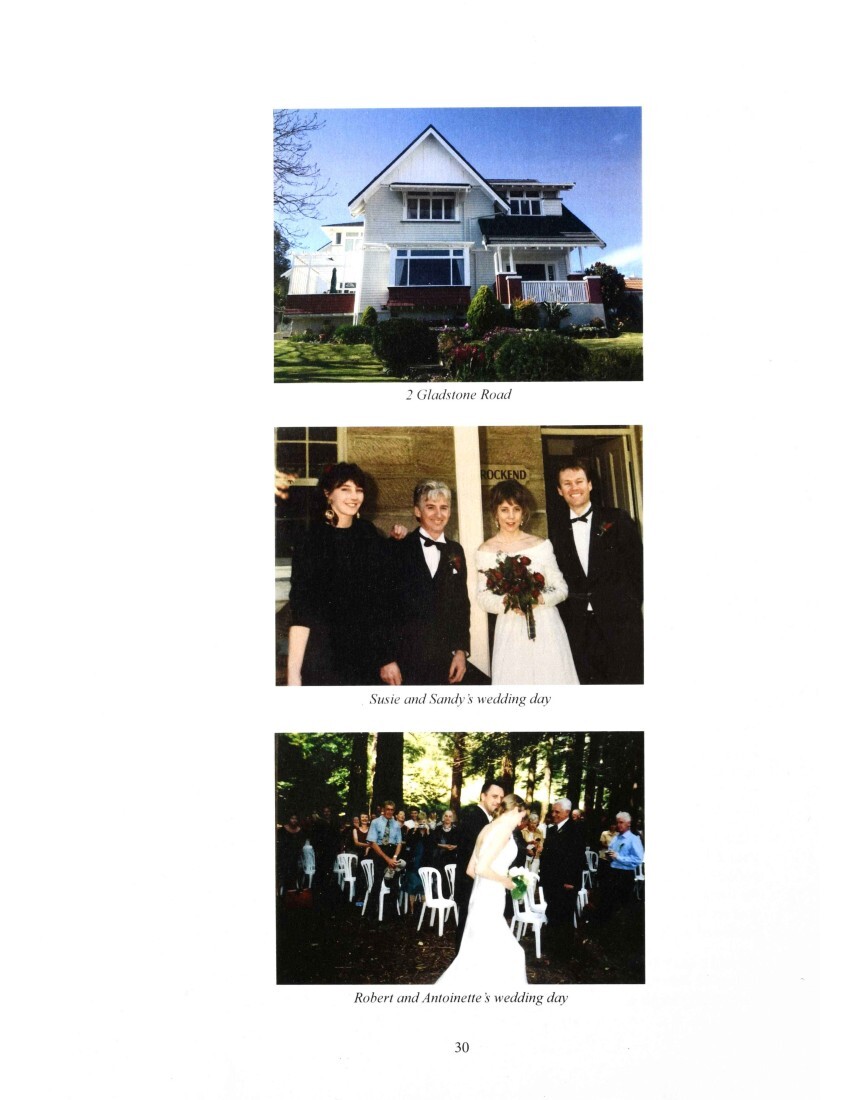










Do you know something about this record?
Please note we cannot verify the accuracy of any information posted by the community.